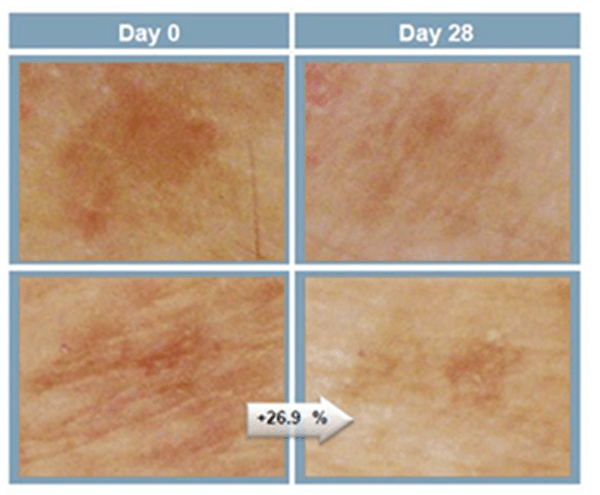List of Ingredients with Their Origins, Anti-Aging, and Pigment-Reducing Effects
Active Ingredients (Relevant for Anti-Aging and Pigment Spots):
Glabridin: Derived from licorice root (Glycyrrhiza glabra).
- Function: Brightens, reduces melanin production, and has anti-inflammatory properties.
- Anti-Aging/Pigment Effect: Helps reduce pigment changes and promote a more even skin tone.
Kojic Acid: Often produced by the fermentation of rice wine (sake).
- Function: Inhibits tyrosinase, the enzyme responsible for melanin production.
- Anti-Aging/Pigment Effect: Lightens pigment spots and uneven skin tone, resulting in a clearer and more uniform complexion.
Arbutin (Alpha-Arbutin): Extracted from plants, including berries (e.g., cranberries, blueberries) and bearberry.
- Function: Inhibits the tyrosinase enzyme and reduces melanin production.
- Anti-Aging/Pigment Effect: Lightens dark spots and creates a more even complexion, reducing the visibility of pigment spots.
Azelaic Acid (Azelamide Mea): Azelaic acid occurs naturally in grains like wheat, rye, and barley; Azelamide Mea is a synthetic derivative.
- Function: Anti-inflammatory, inhibits melanin production, and can reduce redness.
- Anti-Aging/Pigment Effect: May reduce hyperpigmentation and uneven skin tone, while providing a slight smoothing effect.
Vitamin C (3-O-Ethyl Ascorbic Acid): A stable vitamin C derivative. Vitamin C can be sourced synthetically or from citrus fruits.
- Function: Antioxidant that protects against free radicals and supports collagen production.
- Anti-Aging/Pigment Effect: Can brighten skin, improve firmness, and reduce pigment spots, contributing to a more youthful glow.
Kudzu (Pueraria Lobata Root Extract): Derived from the Kudzu root, a plant native to Asia.
- Function: Antioxidant and soothing effect on the skin.
- Anti-Aging/Pigment Effect: Helps protect the skin against signs of aging and can support a more even skin tone.
Other Ingredients:
Aqua (Water): Purified water.
- Function: Solvent and base of the formulation.
Glycerin: Often from vegetable sources.
- Function: Moisturizing humectant that helps bind moisture in the skin.
- Anti-Aging/Pigment: Indirect support by maintaining moisture and skin elasticity.
Niacinamide (Vitamin B3): Synthetic form of vitamin B3.
- Function: Calming, strengthens the skin barrier, reduces unevenness.
- Anti-Aging/Pigment: Can diminish pigment spots, fine lines, and improve skin texture.
Dicaprylyl Ether: A vegetable-based fatty alcohol.
- Function: Emollient that enhances product consistency.
Stearic Acid: A fatty acid often from vegetable sources.
- Function: Thickening agent, emulsifier, stabilizer.
Ethoxydiglycol: A synthetic solvent.
- Function: Improves the penetration of other active ingredients.
Cera Alba (Bees Wax): Beeswax from bees.
- Function: Emulsifier, protective barrier, helps retain moisture.
Cetearyl Alcohol: A fatty alcohol derived from vegetable oils.
- Function: Emulsifier and stabilizer, softening agent.
Caprylic/Capric Triglyceride: Derived from coconut oil and glycerin.
- Function: Light oil, moisturizing, and emollient.
Polyglyceryl-6 Distearate & Polyglyceryl-3 Beeswax: Synthetic emulsifiers.
- Function: Help mix oil and water phases, providing a smooth consistency.
Titanium Dioxide: Mineral pigment.
- Function: UV-protective filter, brightening effect.
Thioctic Acid (Alpha-Lipoic Acid): Antioxidant.
- Function: Combats free radicals, protects against environmental damage.
- Anti-Aging: Supports the skin’s defense against oxidative stress.
Hydrolyzed Brassica Napus Seedcake Extract: Extract from rapeseed.
- Function: Conditioning and nurturing effect on the skin.
Retinyl Palmitate (Vitamin A): An ester form of Vitamin A.
- Function: Promotes cell renewal and collagen production.
- Anti-Aging: Reduces fine lines and improves skin texture and elasticity.
Tocopheryl Acetate (Vitamin E): Antioxidant from vegetable sources.
- Function: Protects against free radicals, supports skin healing.
- Anti-Aging: Maintains a youthful appearance and helps prevent signs of aging.
Jojoba Esters: Derived from the jojoba plant.
- Function: Moisturizing, softening, and skin-conditioning.
Dimethicone: A synthetic silicone.
- Function: Provides a smooth feel, protects the skin surface, and seals in moisture.
Phenethyl Alcohol, Caprylyl Glycol: Preservatives and moisture-retaining agents.
- Function: Extend shelf life, offer mild moisturizing benefits.
Cetyl Alcohol: Fatty alcohol from vegetable sources.
- Function: Emulsifier, moisturizing, and softening agent.
Acrylates/C10-30 Alkyl Acrylate Crosspolymer: Synthetic polymer.
- Function: Thickening agent, stabilizes the formulation.
Disodium Edta: Synthetic chelating agent.
- Function: Stabilizes product shelf life by binding metal ions.
Triethanolamine: pH regulator.
- Function: Adjusts product pH.
Triethoxycaprylylsilane: Silicone-based binder.
- Function: Improves adhesion and consistency.
Sodium Benzoate, Potassium Sorbate: Preservatives.
- Function: Inhibit microbial growth, extend product shelf life.
BHT, BHA: Antioxidants.
- Function: Protect the product from oxidation and rancidity.
Summary:
The product contains a combination of moisturizing, protective, and brightening ingredients. Active ingredients such as Glabridin, Kojic Acid, Arbutin, Azelaic Acid, Vitamin C, and Kudzu target pigment spots and signs of aging. Along with antioxidants, vitamins, and moisture-retaining ingredients, the formulation helps promote a more even, smooth, and youthful-looking complexion while reducing the visibility of pigment spots.


